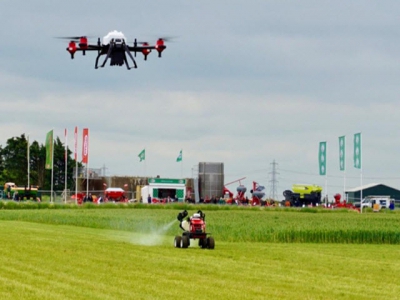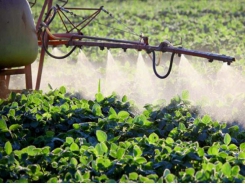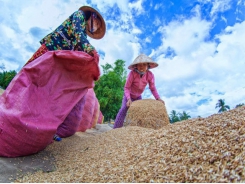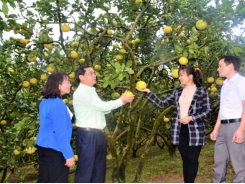New technology improves farming, strengthens agriculture in SW China

New technology is revolutionizing agriculture in Jinya Village of Bazhong City, Sichuan Province. What used to be a time-consuming and costly profession is now powered by technology– thus helping China to revitalize rural areas.
Drones can be programmed to spray pesticides more accurately. /Auto Spray Systems. Photo: CGTN
Traditional farming, which involves manual labor and consumes a lot of time, isn't easy for elderly villagers like Qiu Guangrong, a local villager. But this year, his village upgraded to mechanized production.
"There are more empty-nest elderly people here, since young people are mostly living and working in big cities," said Qiu, "Against that backdrop, we feel the current technology saves considerable time and labor resources compared with traditional agricultural models."
Qiu's village embraces technology not just during the farming process but from one of the first steps – seedling care.
The research team they've been collaborating with comprises of researchers from various universities in Sichuan Province.
Zhang Jue, PhD of Planting and Resource Development of Medicinal Plants of Sichuan Agricultural University, is among those who came to help. She has rich experience in caring for seedlings used in Traditional Chinese Medicine.
Zhang said a big part of their job here is to ensure the quality of the medicine seedlings. The planting process is vital to ensure quality. So before handing them over to the villagers, Zhang and his colleagues use technology such as plant tissue culture technology to ensure the quality and protect them from virus infection.
"They'll be more effective if they grow better," added Zhang.
A local official says "smart agriculture" is saving costs, and functions like real-time monitoring make it possible to trace the whole process and ensure food safety.
"Before we started the digitalization project, this area had used the traditional farming model for thousands of years. The output was not good in the past, and the effect was low," said Cheng Ning, deputy chief of Agriculture and Village Bureau in Enyang District of Bazhong, Sichuan Province.
"After we started to digitize it, we aimed to abandon the old methods of the past and use today's new technology in an attempt to inject new vitality and impetus into our next phase of agricultural farming," he added.
According to the bimonthly Qiushi of China's Communist Party, China's achievements and efforts in fighting poverty have contributed to the global cause of poverty reduction and set a pioneering example of practical significance to the international community.
In the past seven decades, China has managed to lift 850 million people out of poverty, which accounts for more than 70 percent of global poverty alleviation, setting a record in human history. At the end of 2019, the number of impoverished people in China's rural areas fell to 5.51 million from 98.99 million in 2012.
The Ministry of Agriculture and Rural Affairs vowed to focus on four key tasks to achieve rural vitalization. Among these tasks, more will be done to improve rural industries, including the agricultural product processing industry, all for more job opportunities in rural China.
Farming drones: The future of agriculture?
Farmers in deckchairs while the robots do the hard work – that's the tongue-in-cheek message from the team behind XAG's Europe debut at the Cereals Live agricultural show.
Guangzhou-based drone manufacturer XAG, with a large share of China's domestic drone market, is hoping to venture into Europe. The robot manufacturer hopes its lightweight, electric, autonomous devices could help UK farmers deal with labor shortages and the need to become more environmentally friendly and increase yields.
"There is pressure on the environment to reduce carbon, to reduce chemical usage. No one else has a solution to this," said Rob Pearson, CEO of Auto Spray Systems, which is spearheading XAG's Europe debut at the show. "China and XAG, in particular, are miles ahead of competitors because they've been working with this technology since 2013, and we are introducing some of the great advances they've made to the UK market. It will take time, but we're patient."
The hope is that UK farmers will see the potential for electricity-powered robots to take on tasks such as spraying pesticides with precision, meaning fewer chemicals used, while their lightweight construction means less wear on the soil than tractors.
Crowds who saw the demonstration searched for the XAG products on the stand of Harper Adams University. The Chinese company has been working with the University, which has specialized in Agtech, Agricultural-technology, since 2018.
Some orders were placed at the show for the R150, the land robot. However, when it comes to the drone, there are a few more complications. Spraying crops with pesticides has several restrictions under current UK regulations, although the UK government says it is consulting on this matter and welcomes all tech developments it deems helpful.
The big question is, will farmers dig into their pockets? Some farmers told CGTN Europe the price tag of $15,000 for the drone and $20,000 for the field robot means they wouldn't be investing right now but they could see how the machines will benefit the industry in the future.
Richard Falkingham, who runs a large arable family farm in East Yorkshire, said he would consider buying an R150 in the near future. "All that worries me, like any machine you buy, is it reliable? The platform looks fantastic and if it's reliable, then people will buy them," he explained.
XAG is not the only robot company at the show. The Dutch start-up firm AgXeed is continuing a European tour with its Agbot, a robot tractor that can be programmed to work autonomously in a field in predetermined areas and without any human input. Spectators must watch from a distance as the robot will slow down and stop it if it senses someone or something within close range.
Right now, these robots are battling for attention and are getting plenty of it. All those attending the show seemed to agree this is the future face of UK farming, the question is, how quickly will this technology be embraced?
Có thể bạn quan tâm
Phần mềm

Phối trộn thức ăn chăn nuôi

Pha dung dịch thủy canh

Định mức cho tôm ăn

Phối trộn phân bón NPK

Xác định tỷ lệ tôm sống

Chuyển đổi đơn vị phân bón

Xác định công suất sục khí

Chuyển đổi đơn vị tôm

Tính diện tích nhà kính

Tính thể tích ao hồ




 Long An Agriculture Sector - Efforts to complete…
Long An Agriculture Sector - Efforts to complete…  Organic farming - hard to carry out, but…
Organic farming - hard to carry out, but…